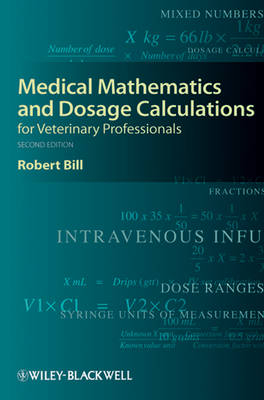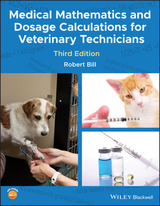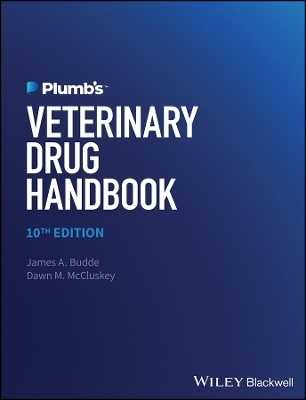
Medical Mathematics and Dosage Calculations for Veterinary Professionals
Iowa State University Press (Verlag)
978-0-8138-2363-8 (ISBN)
- Titel ist leider vergriffen;
keine Neuauflage - Artikel merken
Medical Mathematics and Dosage Calculations for Veterinary Professionals is a useful guide for veterinary health care professionals, veterinary students, and veterinary technicians.
Robert Louis (Pete) Bill, DVM, is Director of Veterinary Technology and Professor of Veterinary Pharmacology at Purdue University School of Veterinary Medicine.
Acknowledgments.
CHAPTER 1: SELF-ASSESSMENT.
Self-Assessment Exercise.
Self-Assessment Exercise Answers.
CHAPTER 2: REVIEW OF DECIMAL NUMBERS IN MEDICAL MATH.
SECTION I: THE BASICS OF DECIMAL NUMBERS.
Relative Values.
Reading Decimal Numbers Aloud.
The Rules for the Use of Zero in Decimal Numbers.
Comparing Decimals Determining Which Number Is Larger at a Glance.
Scientific Notation for Decimal Numbers.
SECTION II: ADDITION AND SUBTRACTION OF DECIMAL NUMBERS.
Tips for Adding and Subtracting Decimals.
SECTION III: MULTIPLICATION OF DECIMAL NUMBERS.
SECTION IV: DIVISION OF DECIMAL NUMBERS.
SECTION V: ROUNDING OF DECIMAL NUMBERS.
CHAPTER 3: FRACTIONS AS THEY APPLY TO MEDICAL MATH.
SECTION I: FRACTION BASICS AND SIMPLIFYING FRACTIONS.
Numerators and Denominators.
The Larger the Denominator, the Smaller the Piece (and the Smaller the Number Value).
Improper Fractions, Proper Fractions, and Mixed Numbers.
Understanding and Using Equivalent Fractions.
Simplifying or Reducing Fractions.
SECTION II: ADDITION AND SUBTRACTION OF FRACTIONS.
Adding Fractions.
Finding the Common Denominator for More Complex Fractions.
Subtraction of Fractions.
Addition of Mixed Numbers.
Subtraction of Mixed Numbers.
SECTION III: MULTIPLICATION OF FRACTIONS.
Multiplication of Improper Fractions.
Multiplication of Whole Numbers and Fractions.
Multiplication of Mixed Numbers.
A Shortcut for Multiplying Fractions.
SECTION IV: DIVISION OF FRACTIONS.
The Reciprocal: What Is It and How Do We Use It?
Division of Fractions.
Division of Mixed Numbers.
SECTION V: CONVERSION OF FRACTIONS TO DECIMALS.
SECTION VI: CONVERSION OF DECIMALS TO FRACTIONS.
Rounding Decimal Fractions and Fractions.
CHAPTER 4: PERCENTAGES.
SECTION I: DEFINITION AND USE OF PERCENTAGES.
Conversion of Percentages to Fractions.
Conversion of Percentages to Decimal Numbers.
Conversion of Fractions to Percentages.
SECTION II: USING PERCENTAGES TO SOLVE PROBLEMS.
Finding the Percentage of a Whole.
Subtracting or Adding the Percentage of the Whole.
Determining Percentages Represented by the Fractional Component.
CHAPTER 5: SOLVING FOR THE UNKNOWN VALUE X.
SECTION I: FINDING THE VALUE OF THE UNKNOWN X IN ADDITION AND SUBTRACTION PROBLEMS.
Analyzing the Problem and Setting Up the Equation.
Moving the Values from One Side of the Equation to the Other.
Moving Negative Numbers or a Negative Unknown X Used in a Subtraction Problem.
SECTION II: FINDING THE VALUE OF THE UNKNOWN X IN MULTIPLICATION AND DIVISION PROBLEMS.
Finding the Unknown X in a Multiplication Problem.
Multiplication Problems Using Fractions and Mixed Numbers.
What to Do When the Unknown X Is in the Denominator in the Problem.
Finding the Unknown X in a Division Problem.
Unknown X Problems Involving Division of Fractions.
CHAPTER 6: DOSAGE CALCULATION AND MEASUREMENTS USED IN VETERINARY MEDICINE.
Different Units, Same Measurements.
SECTION I: METRIC UNITS.
The Basic Units of the Metric System.
Metric Units of Weight or Mass.
Metric Units of Volume.
Metric Units of Length.
Combination of Metric Units to Describe Density or Concentrations.
SECTION II: HOUSEHOLD, APOTHECARY, AND AVOIRDUPOIS UNITS (NONMETRIC UNITS) COMMONLY USED IN VETERINARY MEDICINE.
Common Units.
Conversions between Common Household Measurements.
SECTION III: CONVERTING BETWEEN METRIC AND NONMETRIC MEASUREMENTS COMMONLY USED IN VETERINARY MEDICINE.
The Common Equivalents.
Setting Up a Problem to Convert from One Unit to Another.
Using the Proportion Method.
The Cancel-Out Method.
SECTION IV: ESTIMATING THE ANSWER: DOES YOUR ANSWER MAKE SENSE?
CHAPTER 7: UNDERSTANDING DRUG ORDERS AND DRUG LABELS.
SECTION I: THE DOSAGE REGIMEN.
The Dose, Dosage, and Dose Range.
The Route of Administration.
The Dose Interval.
The Dose Form.
Best Practices for Writing Drug Orders.
Handling Unclear Drug Orders.
SECTION II: DRUG LABELS.
The Drug Name.
Concentration of Drug in the Dose Form.
Dose Formulation and Number of Dose Form Units.
Approved Use for the Drug.
Controlled Substances and Prescription Labeling.
United States Pharmacopoeia (USP) and National Formulary (NF) Label Designations.
Hazard Warnings on the Label.
Storage Information on the Label.
Expiration Dates.
CHAPTER 8: DOSE CALCULATION AND SYRINGE MEASUREMENTS.
SECTION I: PERFORMING THE BASIC DOSE CALCULATION.
Converting the Animal s Weight into the Units Needed to Calculate the Dose.
Types of Dosages Listed.
Putting It All Together Determining the Dose for the Patient.
Proportion Method (Liquid).
Cancel-Out Method (Liquid).
Proportion Method (Tablets).
Cancel-Out Method (Tablets).
What to Do When Tablet Doses Don t Come Out Even.
Dispensing Multiple Units of Drug Form.
Proportion Method.
Cancel-Out Method.
Here Is the Most Common Mistake Students Make When Calculating Total Tablets Dispensed.
SECTION II: DOSING WITH THE SYRINGE.
Types of Syringes Used in Veterinary Medicine.
Syringe Units of Measurement.
Measuring the Amount of Liquid in a Syringe.
CHAPTER 9: CALCULATING INTRAVENOUS INFUSIONS.
SECTION I: INTRAVENOUS INFUSION OF MEDICATION.
Types of IV Administration Sets Used in Veterinary Medicine.
Determining the Fluid Rate Delivered through an IV Administration Set.
Setting the Flow Rate Using the Drip Chamber Rate.
Determining the Total Volume Delivered over Time.
Section I Practice Problems.
SECTION II: CALCULATING INFUSION RATES WHEN ADDING DRUGS TO IV FLUIDS.
Section II Practice Problems.
SECTION III: CALCULATING COMMON FLUID RATES USED IN VETERINARY MEDICINE.
Converting Total Infusion Time to the 12- and 24-Hour Clock Stop Time.
CHAPTER 10: RATIOS, PROPORTIONS, DILUTIONS, AND OTHER CALCULATIONS USED BY VETERINARY PROFESSIONALS.
SECTION I: RATIOS AND PROPORTIONS SOME ADDITIONAL POINTS.
SECTION II: DILUTIONS.
Making Serial Dilutions.
Diluting for Specific Solutions with Specific Volumes.
Compounding to Create Percentage Solutions.
Diluting Percentage Solutions.
SECTION III: CONVERTING TEMPERATURE VALUES FROM FAHRENHEIT TO CELSIUS.
SECTION IV: ROMAN NUMERAL NOMENCLATURE.
Writing Roman Numerals.
Reading Roman Numerals.
Index.
| Erscheint lt. Verlag | 11.8.2009 |
|---|---|
| Verlagsort | Arnes, AI |
| Sprache | englisch |
| Maße | 124 x 187 mm |
| Gewicht | 472 g |
| Themenwelt | Veterinärmedizin ► Klinische Fächer ► Pharmakologie / Toxikologie |
| ISBN-10 | 0-8138-2363-3 / 0813823633 |
| ISBN-13 | 978-0-8138-2363-8 / 9780813823638 |
| Zustand | Neuware |
| Informationen gemäß Produktsicherheitsverordnung (GPSR) | |
| Haben Sie eine Frage zum Produkt? |
aus dem Bereich



